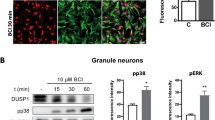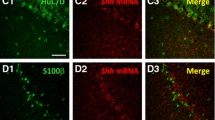Abstract
Purkinje cells establish a glutamatergic synapse with the parallel fibers in the cerebellum. Bergmann glial cells surround this synapse. The transcription factor Stat3, highly expressed in cerebellum, is present in cultures of chick Bergmann glia. Treatment of these cells with L-glutamate induces the tyrosine-phosphorylation of Stat3. The maximal phosphorylation was observed after 15 min and by 30 min returned to basal levels. This effect correlated with Stat3 translocation to nucleus and the appearance of a retarded band in gel mobility shift assays. The effects observed with L-glutamate were mediated through metabotropic glutamate receptors. These results further support the notion that glial cells respond to L-glutamate through changes in the existing proteins and also in gene expression regulation.
Similar content being viewed by others
REFERENCES
Nakanishi, S. 1992. Molecular diversity of glutamate receptors and implications for brain function. Science 258:597–603.
Sonnenberg, J. L., Mitchelmore, C., Macgregor-Leon, P. F., Hempstead, J., Morgan, J. I., and Curran, T. 1989. Glutamate receptor agonists increase the expression of Fos, Fra, and AP-1 DNA binding activity in the mammalian brain. J. Neurosc. Res. 24:72–80.
Müller, T., and Kettenmann, H. 1995. Physiology of Bergmann glial cells. Int. Rev. Neurobiol. 38:341–359.
López, T., López-Colomé, A. M., and Ortega, A. 1998. Changes in GluR4 expression induced by metabotropic receptor activation in radial glia cultures. Mol. Brain. Res. 58:40–46.
Burnashev, N., Khodorova, A., Jonas, J., Helm, P. J., Wisden, H., Monyer, H., Seeburg, P. H., and Sakmann, B. 1992. Calcium-permeable AMPA-kainate receptors in fusiform cerebellar glial cells. Science 256:1566–1570.
López-Colomé, A. M., Ortega, A., Fragoso, G., and Trueba, E. 1997. Excitatory amino acid receptors coupled to the phosphoinositide pathway in Bergmann glia. Neurochem. Res. 22:305–312.
Cid, M. E., and Ortega, A. 1993. Glutamate stimulates (3H) phorbol 12, 13-dibutyrate binding in cultured Bergmann glia cells. Eur. J. Pharmacol. 245:51–54.
López-Colomé, A. M., and Ortega, A. 1997. Activation of p42 mitogen-activated protein kinase by glutamate in cultured radial glia. Neurochem. Res. 22:679–685.
González, M. I., and Ortega, A. 1997. Regulation of the Na+-dependent higy affinity glutamate/aspartate transporter in cultured Bergmann glia by phorbol esters. J. Neurosci. Res. 50:585–590.
Sánchez, G., and Ortega, A. 1994. AMPA/KA receptor induced AP-1 DNA binding activity in cultured Bergmann glia cells. NeuroReport 5:2109–2112.
Gilman, Z. M. 1988. The c-fos serum response element responds to protein kinase C-dependent and-independent signals but not to cyclic AMP. Genes Dev. 2:394–402.
Lerea, L. S., and McNamara, J. O. 1993. Ionotropic glutamate receptor subtypes activate c-fos transcription by distinct calcium-requiring intracellular signaling pathways. Neuron 10:31–41.
Sheng, M., McFadden, G., and Greenberg, E. M. 1990. Membrane depolarization and calcium induce c-fos transcription via phosphorylation of transcription factor CREB. Neuron 4:571–582.
Robertson, L. M., Kerppola, T. K., Vendrell, M., Luk, D., Smeyne, R. J., Bocchiaro, C., Morgan, J. I., and Curran, T. 1995. Regulation of c-fos expression in transgenic mice requires multiple interdependent transcription control elements. Neuron 14:241–252.
Darnell Jr. J. E. 1997. STATs and gene regulation. Science 277:1630–1635.
Planas, A. M., Berruezo, M., Justicia, C., Barrón, S., and Ferrer, I. 1997. Stat3 is present in the developing and adult rat cerebellum and participates in the formation of transcription complexes binding DNA at the sis-inducible element. J. Neurochem. 68:1345–1351.
Ortega, A., Eshhar, N., and Teichberg, V. I. 1991. Properties of kainate receptor/channels on cultured Bergmann glia. Neuroscience 41:335–349.
Wang, T. Y. 1967. The isolation and purification of mammalian cell nuclei. Pages 417–448, in Grossman, L. and Moldave, K. (eds), Methods in Enzymol Vol XII, Academic Press, New York and London.
Wagner, B. J., Hayes, T. E., Hoban, C. J., and Cochran, B. H. 1990. The SIF binding element confers sis/PDGF inducibility onto the c-fos promoter. EMBO. J. 9:4477–4484.
Mistry, R., Prabhu, G., Godwin, M., and Challiss, J. R. A. 1996. Stimulatory effects of the putative metabotropic glutamate receptor antagonist L-AP3 on phosphoinositide turnover in neonatal rat cerebral cortez. Br. J. Pharmacol. 117:1309–1317.
Pellegrini, S., and Dusanter-Fourt, I. 1997. The structure, regulation and function of the Janus kinases (JAKs) and the signal transducers and activators of transcription (STATs). Eur. J. Biochem. 248:615–633.
Conn, P. J., and Pin, J-P. 1997. Pharmacology and functions of metabotropic glutamate receptors. Annu. Rev. Pharmacol. Toxicol. 37:205–237.
Araki, T., Gamper, M., Early, A., Fukuzawa, M., Abe, T., Kawata, T., Kim, E., Firtel, R. A., and Williams J. G. 1998. Developmentally and spatially regulated activation of a Dictyostelium STAT protein by a serpentine receptor. EMBO. J. 17:4018–4028.
Bhat, J. G., Thekkumkara, J. T., Thomas, G. W., Conrad, M. K., and Baker, M. K. 1994. Angiotensin II stimulates sisinducing factor-like DNA binding activity. J. Biol. Chem. 269:31443–31449.
Siciliano, J. C., Gelman, M., and Girault, J. A. 1994. Depolatization and neurotransmitters increase neuronal protein tyrosine phosphorylation. J. Neurochem. 62:950–959.
Umemori, H., Inoue, T., Kume, S., Sekiyama, N., Nagao, M., Itoh, H., Nakanishi, S., Mikoshiba, K., and Yamamoto, T. 1997. Activation of the G protein Gq/11 through tyrosine phosphorylation of the α subunit. Science 276:1878–1881.
Luttrell, L. M., Rocca, J. D., Van Biesen, T., Luttrell, D. K., and Lefkowitz, J. R. 1997. G Subunits mediate Src-dependent phosphorylation of the epidermal growth factor receptor. J. Biol. Chem. 272:4637–4644.
Leaman, D. W., Pisharody, S., Flickinger, T. W., Commane, M. A., Schlessinger, J., Kerr, I. M., Levy, D. E., and Stark, G. R. 1996. Roles of JAKs in activation of STATs and stimulation of c-fos gene expression by epidermal growth factor. Mol. Cell. Biol. 16:369–375.
Cirri, P., Chiarugi, P., Marra, F., Raugei, G., Camici, G., Manao, G., and Ramponi, G. 1997. c-Src activates both STAT1 and STAT3 in PDGF-stimulated NIH3T3 cells. Biochem. Biophys, Res. Comm. 239:493–497.
Zhang, X., Blenis, J., Li, H-C., Schindler, C., and Chen-Kiang, S. 1995. Requirement of serine phosphorylation for formation of STAT-promoter complexes. Science 267:1990–1994.
Author information
Authors and Affiliations
Corresponding author
Rights and permissions
About this article
Cite this article
Aguilera, P., Ortega, A. Stat3 Participates in the Metabotropic Glutamate Signaling Pathway in Bergmann Glial Cells. Neurochem Res 24, 981–986 (1999). https://doi.org/10.1023/A:1021044424103
Issue Date:
DOI: https://doi.org/10.1023/A:1021044424103




